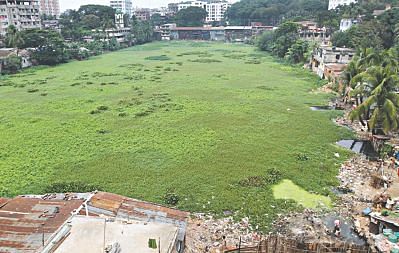Historic Ashkar Dighi shrinking by the day

The once-beautiful historic Ashkar Dighi in Chittagong city barely seems to be a water body due to thickly grown water hyacinths and illegal slums and structures which fence it. Photo: Anurup Kanti Das
The historic Ashkar Dighi is three centuries old and presently covers an area of no less than five acres (about 15 bighas), and so must be protected by law.
The Detailed Area Plan (DAP) of Chittagong Development Authority (CDA) also requires that any water body exceeding 0.5 acre should be preserved.
The authorities concerned, however, seem to be uncaring when the dighi's existence is threatened in encroachment, earth filling, and pollution.
The age-old water body, with which the history of Chittagong city is entwined, was originally 8.49 acres (about 25.5 bighas) back in 1898. It has shrunk to five acres now. The rest was earth-filled and grabbed by influential locals.
Second Mughal Commandant of Chittagong Nawab Abdullah Beg alias Ashkar Khan Bajme Sani dug the dighi to supply water to soldiers in 1669-1671.
Just a decade ago or so, people living around it drank from it and washed clothes and bathed in it. Today it is too polluted for any use. Locals say a hundred slums alongside illegal houses, shops and other structures have sprung up on the four banks. The garbage and filth generated in those slums and houses have been a major source for pollution of Ashkar Dighi.
Ruman Barua, a resident of Jamalkhan area, where the pond is located, said the dighi had turned into a fertile breeding ground of mosquitoes.
"Just 15 years ago, Hindus immersed their idols in the dighi and angling competitions were held regularly,†he said.
The once-beautiful Ashkar Dighi is 7-10 feet deep, but now it looks far from a water body. With water hyacinths thickly covering the entire surface, one would easily mistake it for a huge playground.
A 2010-2011 study shows the concentration of dissolved oxygen (DO), which indicates the purity of water and favourable level of oxygen for survival of aquatic life, is 0-1.1 milligram per litre (mg/L) in the pond water, while its optimum concentration should be 4.5-8 mg/L.
Prof Mohammad Idris Ali, a Chittagong College professor who conducted the study, said they located some 80-90 toilets and sewerage lines of houses, which were discharging waste into the water body.
Councillor of Jamal Khan area Bijoy Kishan Chowdhury said the city corporation removed the water hyacinths in 2009 but they returned within two years. “As it is owned by an individual, it will not clean it in future.†Bijoy, however, admitted that if the pond was filled up, a heritage would be lost.
According to Bangladesh Survey (BS), published in 1987, the government owns one fourth of Ashkar Dighi, and the rest belongs to 28 individuals.
Locals said different parts of the four banks had already been taken up by different people, and many of them built slums, shops and houses. The slum people said they heard that Chittagong City Corporation (CCC) was the owner of the dighi.
Runa Begum, a slum dweller, however, said they paid Tk 1,700 to 2,000 for each shanty to Md Hanif and Md Karim as the "owners".
MA Rahim, manager of Madina Furniture shop on the dighi's north bank, said they heard that Ship Breakers' Association's former vice president Shawkat Ali Chowdhury "owned" the dighi. “Shawkat also owns the slums and manages those by some caretakers."
This correspondent called Shawkat by phone several times and sent him SMSs for comments but he did not respond.
Eminent prosecution lawyer Rana Dasgupta said it was a long-time public demand to free its banks and turn the “dighi†into an open space.
“If any legal owner exists, the state can acquire the land and reservoir for the greater interest of the masses under the acquisition law,†he said. “If no real owner exists, the government should go for eviction.â€
At least four government offices--CCC, CDA, District Administration, and the Department of Environment (DoE)--have roles to play in preserving the dighi.
Town planner Engineer Ali Ashraf suggested CDA or CCC should place a total plan, measuring the estimated cost and preparing a design, before their line ministry to develop it into a recreational centre.
“I think, CDA is the perfect organisation to do that,†said Ashraf, an expert involved in formulating Detailed Area Plan (DAP) and the CDA master plan. The master plan stressed turning the dighi into a recreational park and open space.
DoE (Chittagong) Director Jafor Alam said the local administration could acquire the dighi under the Tank Preservation Act, 1939.
Asked why the DoE is resisting its encroachment, he said if they got any proof, they would take legal action against the offenders.
CDA deputy chief town planner Sarwar Uddin Ahmed said, “CDA will not permit any construction on the dighi. If anyone builds any structure, CDA will remove it under Building Construction Act 1952.â€
Mayor Manjur Alam said, “If the government acquires the dighi and hands it over to CCC, we will develop it into a recreational park."

 For all latest news, follow The Daily Star's Google News channel.
For all latest news, follow The Daily Star's Google News channel. 



Comments